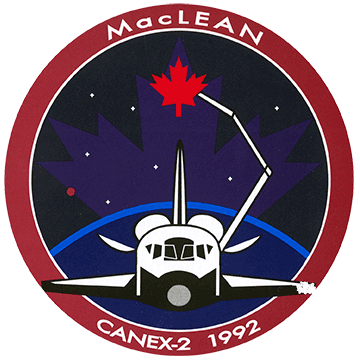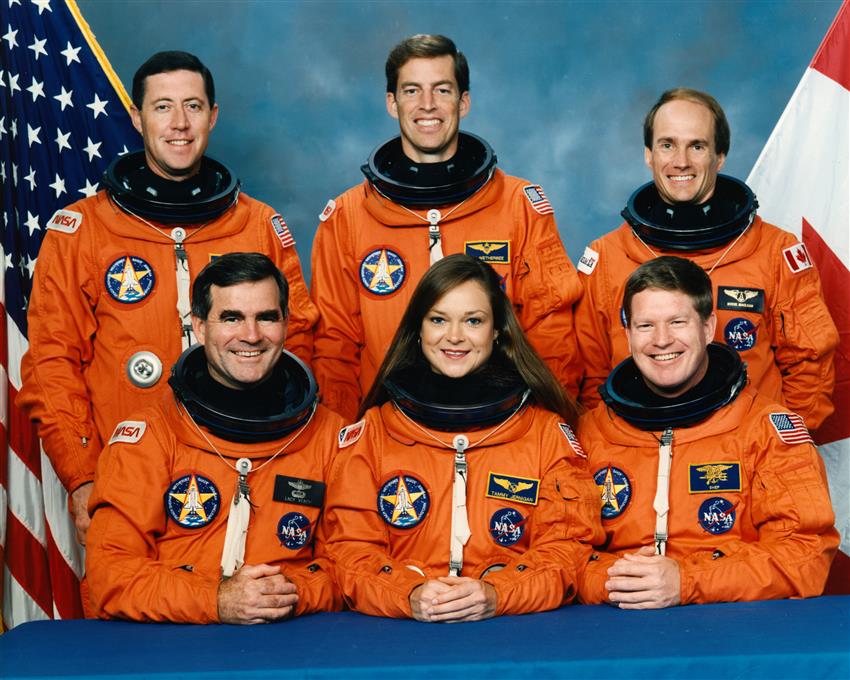Mission STS-52

Mission description

Text version
The MacLean Mission insignia commemorates and symbolizes all aspects of Canada's participation in Shuttle Mission STS-52.
The red maple leaf represents Canadian participation in the flight: flight hardware and software were developed in Canada, and Canadian experiments were performed by Canadian astronaut Steve MacLean. The larger, purple maple leaf rising over the horizon recalls the Northern Lights (Aurora borealis) over Canada. Canadian space science beginnings stem from research into the Aurora.
The Canadarm is depicted extending from the shuttle and grasping the maple leaf since the Canadarm was used extensively during the mission in the evaluation of the Canadian Space Vision System (SVS). The Canadarm also represents other Canadian hardware aboard, such as the SVS, which improved the Canadarm's operational performance. The Earth is shown with a blue band, symbolizing its fragile atmosphere and the significance of space research applied to atmospheric science. During the mission, two Canadian experiments provided data about the upper atmosphere: one investigation examined data on night glow phenomena and the other researched the stratosphere with respect to the Earth's protective ozone layer.
The five stars to the left of the tail of the shuttle and the two to the right indicate the mission flight number (52), as well as the number of Canadian experiments performed during the mission (5+2-7).
Mars is depicted to the left of the sky, just above the Earth. The research being conducted on this flight will contribute towards future missions to the red planet. Research in the material sciences will help increase our knowledge of how plastics and composite materials used in the construction of spacecraft degrade in the harsh environment of space. Scientists and engineers will be able to try new protective coatings and test materials designed for use on specific space hardware such as the International Space Station (ISS). The Canadian SVS technology may be used in the future to explore Mars. The life science experiments, which help increase our understanding of the body's adaptation to space flight, will enable humans to prepare for more extended periods in space, such as missions to Mars.
Patch STS-52. (Credit: Canadian Space Agency)
Launch
Date: October 22, 1992
Time: 1:09:39 p.m. EDT
Site: Kennedy Space Center (KSC)
Landing
Date: November 1, 1992
Time: 9:05:52 a.m. EST
Site: Kennedy Space Center (KSC)
Mission duration: 9 days 20 h 56 min 13 s
Flight number: STS-52
Orbiter vehicle: Columbia
Payloads: CANadian EXperiments (CANEX-2) consisting of seven experiments, Laser Geodynamic Satellite (LAGEOS), Attitude Sensor Package (ASP), and the United States Microgravity Payload (USMP) consisting of 3 experiments.
Space Shuttle Columbia made its thirteenth flight when it lifted off, in October 1992, on Mission STS-52. This flight orbited the Earth in a circular trajectory at an altitude of 296 km and for most of the ten day mission. It dropped to 214 km on the last two days of the mission at an inclination of 28.5 degrees.
The payloads included the Italian Laser Geodynamic Satellite (LAGEOS) which was used to monitor continental drift. The Italian Research interim Stage (IRIS) was used to boost the satellite to its proper orbit.
The United States Microgravity Payload (USMP) consisted of three experiments: "Matériel pour l'Étude des Phénomènes Intéressant la Solidification sur Terre et en Orbite" (MEPHISTO); Lambda Point Experiment (LPE); and the Space Acceleration Measurement System (SAMS). Another payload was the Attitude Sensor Package which contained a Modular Star Sensor (MOS), infrared Earth Sensor (LACES) and Yaw Earth Sensor (YESS).
The CANadian set of EXperiments (CANEX-2) was conducted by Dr. Steve MacLean. The seven experiments in space technology, space science, materials processing, and life sciences had potential terrestrial applications in widely divergent areas.
The Canadarm also flew and is shown attached to the side of the cargo hay. The Canadarm was used to deploy the Canadian Target Assembly (CTA) satellite in the evaluation of the Space Vision System (SVS). At the time of the mission, the SVS was an experimental machine vision system which was expected to enhance human vision in the sometimes unfavourable viewing conditions of space.

Mission STS-52 crew
From left to right. Back row: Michael A. Baker, James D. Wetherbee and Steve MacLean. Front row: Charles L. Veach, Tamara E. Jernigan, William M. Shepherd. (Credit: NASA)